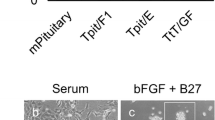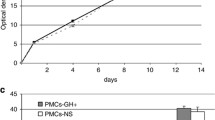Summary
The growth of GH4C1, GH3, GH1, and GH3C15 rat pituitary tumor cell lines was studied in a serum-free medium (designated TRM-1) formulated with 1∶1 (vol/vol) mixture of Ham's F12 nutrient mixture and Dulbecco's modified Eagle's medium (F12-DME) containing 15 mM 4-(2-hydroxyethyl)-1-piperazineethanesulfonic acid (HEPES), 50 μg/ml gentamicin supplemented with 10 μg/ml bovine insulin, 10 μg/ml human transferrin (Tf), 10 ng/ml selenous acid, 10 nM 3,5,3′-triiodothyronine (T3), 50 μM ethanolamine (Etn), and 500 μg/ml bovine serum albumin. Of the lines evaluated, only the GH1 failed to grow in TRM-1. Passage of the GH4C1 and GH3 lines from serum-containing medium into TRM-1 caused an initial selection resulting in cells that grew progressively at higher rates and finally were maintained indefinitely in TRM-1. These populations showed a requirement for supraphysiologic concentrations of T3 (1.0 to 10 nM). After adaptation of the GH4C1 line in TRM-1 for ≤20 generations, removal of components gave a less complex mixture containing 15 mM HEPES, 50 μ/ml gentamicin, 10 μg/ml Tf, 10 nM T3, and 50 μM Etn (designated TRM-2) that supported serial passage of the cells. Under these conditions, thyroid hormone dependence was lost progressively. When T3 was removed from TRM-2 adapted cells, a third population was selected that no longer required thyroid hormones and was only slightly stimulated by T3. These studies demonstrated that the combination of serum-containing and serum-free conditions can be used to select pituitary cell populations that a) required both serum-factor(s) and T3 for optimum growth, b) required supraphysiologic concentrations of T3 without serum proteins other than Tf and albumin, and c) were completely autonomous in that they proliferated in medium supplemented only with Tf and nutrients without necessity of other serum factor(s) or T3.
Similar content being viewed by others
References
Gardner, W. U.; Kirschbaum, A.; Strong, L. C. Lymphoid tumors in mice receiving estrogens. Arch. Pathol. 29:1–7; 1940.
Allen, E.; Gardner, W. U. Cancer of the cervix of the uterus in hybrid mice following long-continued administration of estrogen. Cancer Res. 1:359–366; 1941.
Hooker, C. W.; Pfeiffer, C. A. The morphology and development of testicular tumors in mice of the “A” strain receiving estrogens. Cancer Res. 2:759–760; 1942.
Kirkman, H. Estrogen-induced tumors of the kidney in the syrian hamster. Natl. Cancer Inst. Monogr. 1:1–139; 1959.
Kim, U.; Furth, J.; Yannopoulos, K. Observations on hormonal control of mammary cancer. I. Estrogen and mammotropes. JNCI 31:233–259; 1964.
Furth, J. Experimental pituitary tumors. In: Pincus, G., ed. Recent progress in hormone research, vol. 11. Orlando: Academic Press, Inc.; 1955:221–236.
Furth, J.; Clifton, K.; Gadsen, E., et al. Dependent and autonomous mammotropic pituitary tumors in rats: their somatotropic features. Cancer Res. 16:608–616; 1956.
Wiklund, J. A.; Gorski, J. Genetic differences in estrogen-induced deoxyribonucleic acid synthesis in the rat pituitary: correlations with pituitary tumor susceptibility. Endocrinology 111:1140–1149; 1982.
Lis, M.; Cantin, M.; Marchisio, A.-M., et al. Estrone-induced, prolactin secreting and dopamine sensitive rat pituitary tumor. Eur. J. Clin. Oncol. 20:829–839; 1984.
Haran-Ghera, N.; Furth, J.; Buffet, F., et al. Studies on the pathogenesis of neoplasms by ionizing radiation. II. Neoplasms of endocrine organs. Cancer Res. 19:1181–1187; 1959.
Yokoro, K.; Furth, J.; Haran-Ghera, N. Induction of mammotropic pituitary tumors by x-rays in rats and mice: the role of mammotropes in development of mammary tumors. Cancer Res. 21:178–186; 1961.
Tashjian, A. H.; Yasumura, Y.; Levine, L., et al. Establishment of clonal strains of rat pituitary tumor cells that secrete growth hormone. Endocrinology 82:342–352; 1968.
Tashjian, A. H.; Bancroft, F. C.; Levine, L. Production of both prolactin and growth hormone by clonal strains of rat pituitary tumor cells. Differential effects of hydrocortisone and tissue extracts. J. Cell Biol. 47:61–70; 1970.
Bancroft, F. C.; Tashjian, A. H. Growth in suspension culture of rat pituitary cells which produce growth hormone and prolactin. Exp. Cell Res. 64:125–128; 1971.
Sorrentino, J. M.; Kirkland, W. L.; Sirbasku, D. A. Control of cell growth. I. Estrogen-dependent growth in vivo of a rat pituitary tumor cell line. JNCI 56:1149–1154; 1976.
Sorrentino, J. M.; Kirkland, W. L.; Sirbasku, D. A. Control of cell growth. II. Requirement of thyroid hormones for the in vivo estrogen-dependent growth of a rat pituitary tumor cells. JNCI 56:1155–1158; 1976.
Kirkland, W. L.; Sorrentino, J. M.; Sirbasku, D. A. Control of cell growth. III. Direct mitogenic effect of thyroid hormones on an estrogen-dependent rat pituitary tumor cell line. JNCI 56:1159–1164; 1976.
Tashjian, A. H. Clonal strains of hormone-producing pituitary cells. Methods Enzymol. 58:527–535; 1979.
Bancroft, F. C. GH cells: functional clonal lines of rat pituitary tumor cells. In: Sato, G., ed. Functionally differentiated cell lines. New York: Alan R. Liss, Inc.; 1981:47–59.
Herrera, E.; Morrele de Escobar, G., Escobar del Rey, F. Differential effects of methylmercaptoimodazole and propylthiouracil on thyroid 131-I release in rats on perchlorate. Endocrinology 83:671–677; 1968.
Mayberry, W. E.; Astwood, E. B. The effects of propylthiouracil on the intrathyroid metabolism of iodine in rats. J. Biol. Chem. 235:2977–2980; 1960.
Oppenheimer, J. H.; Schwartz, H. L.; Surks, M. I. Propylthiouracil inhibits the conversion ofL-thyroxine toL-triiodothyronine. J. Clin. Invest. 51:2493–2497; 1972.
Riss, T. L.; Sirbasku, D. A. Rat pituitary tumor cells in serum-free medium. II. Serum factor and thyroid hormone requirements for estrogen-responsive growth. In Vitro 25:136–142; 1989.
Sirbasku, D. A.; Riss, T. L. Growth of GH4C1 rat pituitary tumor cells in hormonally defined serum-free medium. J. Cell Biol. 103(pt 2):15a; 1986.
Gospodarowicz, D. Isolation and characterization of acidic and basic fibroblast growth factor. Methods Enzymol. 147:106–119; 1987.
Burleigh, B. D.; Meng, H. Development of a biosynthetic somatomedin C/IGF-I as a product for cell culture. Am. Biotechnol. Lab. 4:48–53; 1986.
Riss, T. L.; Ogasawara, M.; Karey, K. P., et al. Use of serum-free hormonally defined media to evaluate the effects of growth factors and inhibitors on proliferation of estrogen-responsive mammary and pituitary tumor cells in culture. J. Tissue Cult. Methods 10:133–150; 1986.
Stewart, B. H.; Sirbasku, D. A. Requirement of a serum factor to support thyroid hormone dependent growth of GH, cells in defined medium. J. Cell. Biol. 105(pt 2):23a; 1987.
Kano-Seuoka, T.; Errick, J. E. Roles of phosphoethanolamine, ethanolamine, and prolactin on mammary cell growth. In: Sato, G. H.; Pardee, A. B.; Sirbasku, D. A. eds. Cold Spring Harbor Conferences on Cell Proliferation, vol. 9. Cold Spring, Harbor, NY: Cold Spring Harbor Press; 1982:727–740.
Hayashi, I.; Larner, J.; Sato, G. Hormonal growth control of cells in culture. In Vitro 14:23–30; 1978.
Neufeld, G.; Gospodarowicz, D. Basic and acidic fibroblast growth factors interact with the same cell surface receptor. J. Biol. Chem. 261:5631–5637; 1986.
Riss, T. L.; Sirbasku, D. A. Growth and continuous passage of COMMA-D mouse mammary epithelial cells in hormonally defined serum-free medium. Cancer Res. 47:3776–3782; 1987.
Karey, K. P.; Sirbasku, D. A. Differential responsiveness of the human breast cancer cell lines MCF-7 and T47D to growth factors and 17β-estradiol. Cancer Res. 48:4083–4092; 1988.
Ogasawara, M.; Sirbasku, D. A. A new serum-free method of measuring growth factor activities for human breast cancer cells in culture. In Vitro 24:911–920; 1988.
Greenstein, L. A.; Nissley, S. P.; Moses, A. C., et al. Purification of multiplication-stimulating activity. In: Barnes, D. W.; Sirbasku, D. A.; Sato, G. H., eds. Methods for preparation of media, supplements and substrata for serum-free animal cell culture, vol. 1. New York: Alan R. Liss, Inc.; 1984:111–138.
Hayashi, I.; Sato, G. H. Replacement of serum by hormones permits growth of cells in defined medium. Nature 259:132–134; 1976.
Johnson, L. K.; Baxter, J. D.; Vlodavsky, I., et al. Epidermal growth factor and expression of specific genes: effects on cultured rat pituitary cells are dissociable from mitogenic response. Proc. Natl. Acad. Sci. USA 77:394–398; 1980.
Schonbrunn, A.; Krasnoff, M.; Westendorf, J. M. et al. Epidermal growth factor and thyrotropin-releasing hormone act similarly on a clonal pituitary cell strain: modulation of hormone production and inhibition of cell proliferation. J. Cell Biol. 85:786–797; 1980.
Barnes, D. W.; Sirbasku, D. A. Peptide growth factors. Methods in enzymology, part A, vol. 146. Orlando: Academic Press, Inc.; 1987.
Barnes, D. W.; Sirbasku, D. A., eds. Peptide growth factors. Methods in enzymology, part B, vol. 147. Orlando: Academic Press, Inc.; 1987.
Samuels, H. H.; Tsai, J. S.; Cintron, R. Thyroid hormone action: a cell-culture system responsive to physiological concentrations of thyroid hormones. Science 181:1253–1256; 1973.
Stewart, B. H.; Sirbasku, D. A. Identification of a serum factor which mediates thyroid hormone dependent growth of GH1 rat pituitary tumor cells in defined medium. FASEB J. 2:A359; 1988.
Samuels, H. H.; Tsai, J. S.; Casanova, J., et al. Thyroid hormone action: in vitro characterization of solubilized nuclear receptor from rat liver and cultured GH1 cells. J. Clin. Invest. 54:853–865; 1974.
Samuels, H. H.; Shapiro, L. S. Thyroid hormone stimulates de novo growth hormones synthesis in cultured GH1 cells: evidence for accumulation of a rate limiting RNA species in the induction process. Proc. Natl. Acad. Sci. USA 73:3369–3373; 1976.
Kumari-Siri, M. H.; Surks, M. I. Regulation of growth hormone mRNA synthesis by 3,5,3′-triiodothyronine in cultured growth hormone producing rat pituitary tumor cells (GC). Dissociation between nuclear iodothyronine receptor concentration and growth hormone mRNA synthesis in (S) phase of the cell cycle. J. Biol. Chem. 260:14529–14537; 1985.
Thompson, C. C.; Weinberger, C.; Lebo, R., et al. Identification of a novel thyroid hormone receptor expressed in the mammalian central nervous system. Science 237:1610–1614; 1987.
Hinkle, P. M.; Kinsella, P. A. Thyroid hormone induction of an autocrine growth factor secreted by pituitary tumor cells. Science 234:1549–1552; 1986.
Miller, M. J.; Fels, E. C.; Shapiro, L. E., et al.L-Triiodothyronine stimulates growth by means of an autocrine factor in a cultured growth hormone-producing cell line. J. Clin. Invest. 79:1773–1781; 1987.
Fagin, J. A.; Pixley, S.; Slanina, S., et al. Insulin-like growth factor I gene expression in GH3 rat pituitary cells: messenger ribonucleic acid content, immunocytochemistry and secretion. Endocrinology 120:2037–2043; 1987.
Rosenfeld, R. G.; Ceda, G.; Cutler, C. W., et al. Insulin and insulin-like growth factor (somatomedin) receptors on cloned rat pituitary tumor cells. Endocrinology 117:2008–2016; 1985.
Author information
Authors and Affiliations
Additional information
This work was supported by grants CA-26617 and CA-38024 from the National Cancer Institute, Bethesda, MD, American Cancer Society grant BC-255, and grant 2225 from the Council for Tobacco Research, Inc., USA.
Rights and permissions
About this article
Cite this article
Riss, T.L., Stewart, B.H. & Sirbasku, D.A. Rat pituitary tumor cells in serum-free culture. I. Selection of thyroid hormone-responsive and autonomous cells. In Vitro Cell Dev Biol 25, 127–135 (1989). https://doi.org/10.1007/BF02626168
Received:
Accepted:
Issue Date:
DOI: https://doi.org/10.1007/BF02626168




